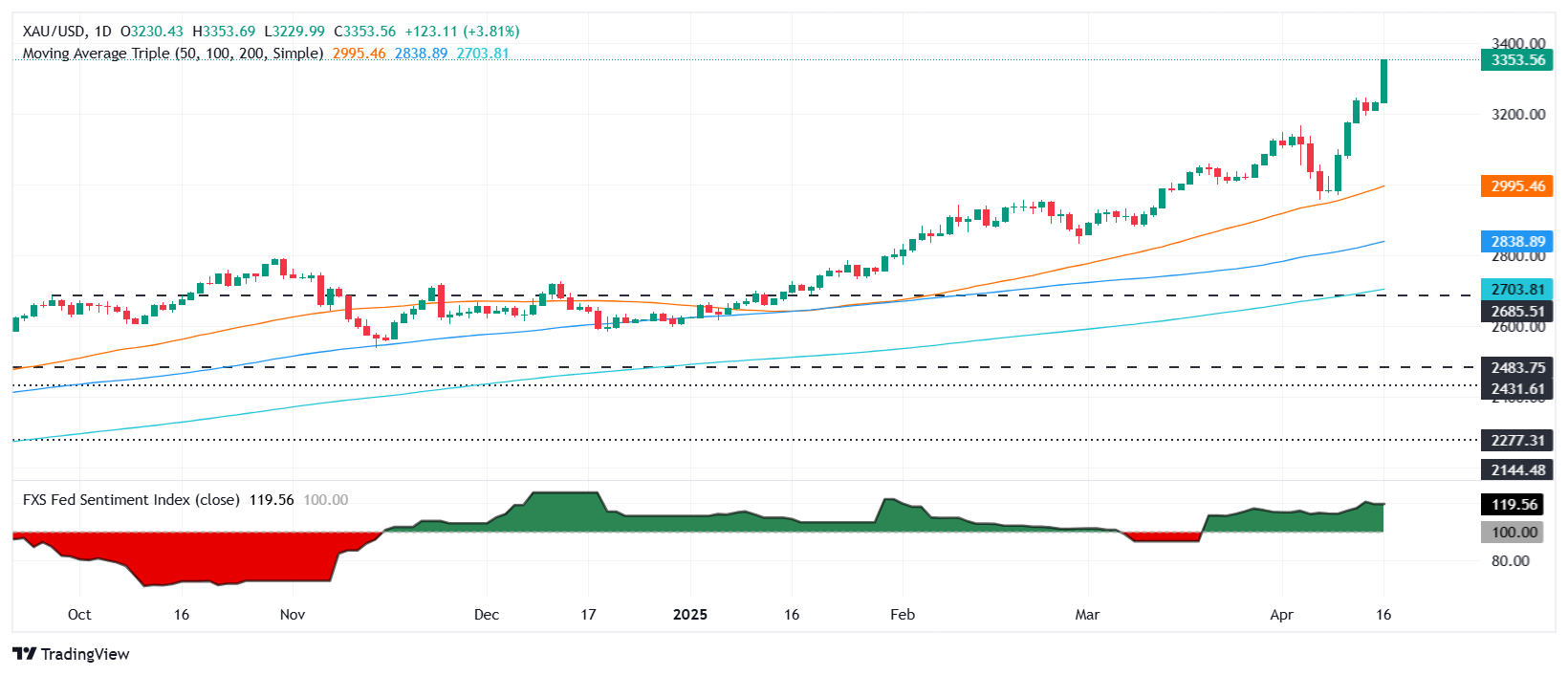- Gold reaches a third historical maximum this week as the commercial war intensifies; Trump points to the imports of rare earths in China.
- DXY falls 0.83% to 99.17, promoting gold while investors seek security amid global economic uncertainty.
- Powell says that the Fed must be kept vigilant about inflation, reducing the hopes of cuts; Attention focuses on unemployment applications and housing data.
The price of gold extended its record streak for the third time in the week as the dollar weakened due to tensions between China and the US related to commercial policies. These tensions are increasing the attractiveness of security assets such as precious metals. At the time of writing, the Xau/USD is traded at $ 3,342, with an increase of more than 3.50%.
The escalation of the commercial war cool the feeling, since the US president Donald Trump ordered an investigation to apply tariffs to rare earth imports, intensifying the dispute with China.
The ingot reached historical maximums on Monday and Wednesday, with the historical maximum (ATH) reaching $ 3,343. Meanwhile, the US dollar index (DXY), which tracks the yield of the dollar against a basket of six coins, fell 0.83% to 99.17.
Meanwhile, the president of the Fed, Powell, destroyed the expectations of feat cuts by emphasizing that the Central Bank must ensure that tariffs do not trigger a more persistent increase in inflation.
“Our obligation is to keep long -term inflation expectations anchored and ensure that a specific increase in price level does not become a problem of continuous inflation,” Powell said in the Chicago Economic Club.
In terms of data, US retail sales exceeded projections, compared to the previous reading. The industrial production of the United States hinted that manufacturing activity continued to slow down,
This week, gold merchants expect housing data and initial unemployment applications.
Daily summary of market movements: The price of gold capitalizes profits before the fall of US yields.
- The 10 -year Treasury performance from the US fell almost six basic points to 4,281%. The real US yet yields fell three and a half points to 2,111%, as shown by the yields of the US Treasury values protected against inflation at 10 years that failed to contain gold prices.
- The president of the Fed, Powell, revealed that a weakened economy and high inflation could conflict with the two objectives of the Central Bank, making possible a stagflation scenario.
- “We could find ourselves on the challenging stage in which our dual mandate goals are in tension,” he said. “If that happened, we would consider how far the economy of each objective is, and the different potential time horizons on which it would be anticipated that those respective gaps would close.”
- The monetary market participants had discounted 91 basic points of relief by the FED towards the end of 2025. The first cut in July is expected.
- In terms of data, US retail sales increased 1.4% month by month in March, exceeding 1.3% and increasing from 0.2% in February, driven by strong car sales. However, the control group – used for GDP calculations – only increased 0.4%, below 1.3%and without reaching the 0.6%estimate.
- The Federal Reserve announced that industrial production fell 0.3% in March, after an increase of 0.8% in February.
- Xau/USD technical perspective: The price of gold is prepared to test new historical maximums at $ 3,400
The upward trend of gold price remains with buyers looking at the figure of $ 3,350. A rupture of this last will present the figure of $ 3,400, followed by key psychological levels such as $ 3,450 and $ 3,500.
On the contrary, if the Xau/USD falls below $ 3,300, the first support would be the minimum of April 16, $ 329, followed by the figure of $ 3,200.

FAQS GOLD
Gold has played a fundamental role in the history of mankind, since it has been widely used as a deposit of value and a half of exchange. At present, apart from its brightness and use for jewelry, precious metal is considered an active refuge, which means that it is considered a good investment in turbulent times. Gold is also considered a coverage against inflation and depreciation of currencies, since it does not depend on any specific issuer or government.
Central banks are the greatest gold holders. In their objective of supporting their currencies in turbulent times, central banks tend to diversify their reserves and buy gold to improve the perception of strength of the economy and currency. High gold reserves can be a source of trust for the solvency of a country. Central banks added 1,136 tons of gold worth 70,000 million to their reservations in 2022, according to data from the World Gold Council. It is the largest annual purchase since there are records. The central banks of emerging economies such as China, India and Türkiye are rapidly increasing their gold reserves.
Gold has a reverse correlation with the US dollar and US Treasury bonds, which are the main reserve and shelter assets. When the dollar depreciates, the price of gold tends to rise, which allows investors and central banks to diversify their assets in turbulent times. Gold is also inversely correlated with risk assets. A rebound in the stock market tends to weaken the price of gold, while mass sales in higher risk markets tend to favor precious metal.
The price of gold can move due to a wide range of factors. Geopolitical instability or fear of a deep recession can cause the price of gold to rise rapidly due to its condition of active refuge. As an asset without yield, the price of gold tends to rise when interest rates lower, while the money increases to the yellow metal. Even so, most movements depend on how the US dollar (USD) behaves, since the asset is quoted in dollars (Xau/USD). A strong dollar tends to keep the price of gold controlled, while a weakest dollar probably thrusts gold prices.
Source: Fx Street
I am Joshua Winder, a senior-level journalist and editor at World Stock Market. I specialize in covering news related to the stock market and economic trends. With more than 8 years of experience in this field, I have become an expert in financial reporting.







